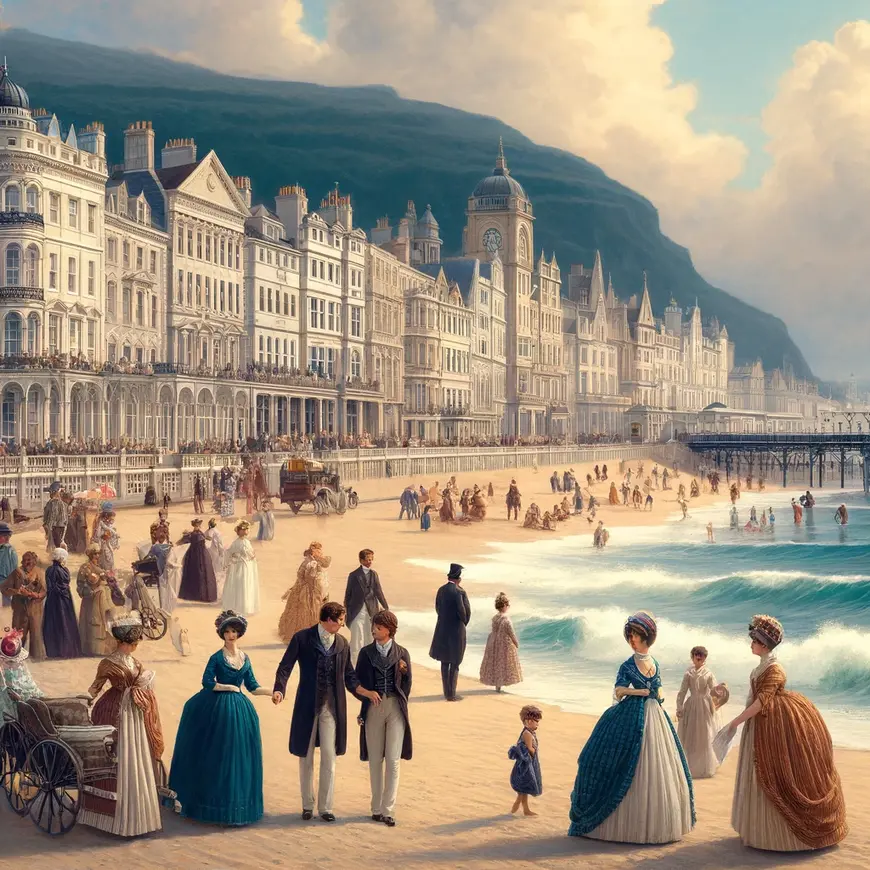Jane Austen’s Unfinished Gem – “Sanditon”
In the world of classic literature, Jane Austen’s name sparkles like a literary gem, and “Sanditon” offers readers an opportunity to witness the masterful craft of the beloved author once again. While Austen left this novel unfinished due to her untimely death, the fragments she bequeathed are enough to tantalize and transport readers to the seaside village of Sanditon. This review embarks on a journey into Austen’s final work, exploring its charm, wit, and the tantalizing hints of the world she left behind.
Plot Overview: “Sanditon”
“Sanditon” introduces us to Charlotte Heywood, a spirited young woman invited to the tranquil seaside resort of Sanditon by the generous Mr. Parker. The Parkers are eager to transform Sanditon into a fashionable health resort, envisioning a haven for the ailing and a playground for the elite.
As Charlotte explores the village, she encounters a delightful array of characters, each with their quirks and ambitions. From the eccentric Lady Denham, a wealthy widow with a penchant for matchmaking, to the charming Sidney Parker, the dynamic characters breathe life into Austen’s seaside canvas.
The novel takes shape as Charlotte becomes a keen observer of the societal machinations in Sanditon, unveiling the intricate dance of relationships and the clash between old traditions and the burgeoning changes of the Regency era.

Characterization
Austen’s prowess in character creation shines brightly in “Sanditon.” Charlotte Heywood, the novel’s protagonist, embodies the qualities of an Austen heroine – intelligent, independent, and with a keen sense of observation. Her presence provides readers with a lens through which to explore the dynamics of Sanditon.
The Parkers, with their entrepreneurial spirit, add a touch of comedic charm to the narrative. Mr. Parker’s enthusiasm for turning Sanditon into a fashionable resort and Mrs. Parker’s preoccupation with her numerous ailments create a lively backdrop for the unfolding drama.
Sidney Parker, the dashing and enigmatic brother, becomes a central figure in the story, capturing Charlotte’s attention and sparking the romantic tension typical of Austen’s works. The novel introduces a host of other characters, each contributing to the tapestry of Sanditon’s social landscape.
Themes: “Sanditon”
“Sanditon” grapples with themes that resonate throughout Austen’s oeuvre. The clash between tradition and progress takes center stage as Sanditon transforms from a quiet seaside village to a bustling resort town. Austen explores the impact of societal change on both the physical landscape and the relationships between its inhabitants.
The theme of matchmaking, a recurring motif in Austen’s novels, reappears with Lady Denham’s attempts to orchestrate unions among the characters. The novel delves into the complexities of love and marriage, exposing the societal expectations that influence romantic relationships.
Austen also touches on the challenges faced by women in the Regency era, highlighting their limited agency and the importance of advantageous marriages. The subtle social commentary adds depth to the narrative, inviting readers to reflect on the constraints faced by characters like Charlotte Heywood.
Austen’s Signature Wit
Austen’s razor-sharp wit, a hallmark of her writing, is on full display in “Sanditon.” The novel is infused with clever dialogue, ironic observations, and the author’s unique ability to satirize the societal norms of her time. Austen’s humor adds a delightful layer to the narrative, making the novel both entertaining and thought-provoking.
The characters’ interactions, especially the banter between Charlotte and Sidney, reveal Austen’s keen understanding of human nature. The wit serves not only as a source of amusement but also as a tool for dissecting the absurdities and pretensions of Regency society.
Setting
Austen’s skill in crafting vivid settings comes to the fore in “Sanditon.” The seaside village, with its bracing air and promise of health benefits, becomes more than just a backdrop; it’s a character in itself. The changing dynamics of Sanditon, from a quiet coastal retreat to a burgeoning resort, mirror the societal shifts taking place within its boundaries.
The descriptions of Sanditon’s landscapes, the grandeur of Lady Denham’s residence, and the daily life of its inhabitants contribute to the immersive experience. Austen’s ability to transport readers to the heart of Regency England remains unparalleled, even in this unfinished work.
Romantic Tension
“Sanditon” introduces readers to a classic Austenian dilemma – the dance of romance and societal expectations. The tension between Charlotte Heywood and Sidney Parker simmers beneath the surface, creating an anticipation that remains unresolved due to the novel’s incomplete nature.
Austen’s exploration of the complexities of love, courtship, and the social pressures surrounding romantic relationships is evident in the interactions between the characters. The novel’s fragmentary state leaves readers yearning for the resolution of the romantic entanglements hinted at in the narrative.

Unfinished Symphony: “Sanditon”
The bittersweet aspect of “Sanditon” lies in its unfinished nature. Austen’s untimely death left the novel a fragment, with the narrative ending abruptly. The absence of a neatly tied conclusion is felt keenly by readers, who are left to wonder about the destinies of the characters they’ve come to know and love.
Despite its incompleteness, “Sanditon” remains a testament to Austen’s storytelling prowess. The fragment serves as a tantalizing glimpse into the author’s creative process, leaving readers to imagine the potential outcomes and resolutions that Austen might have crafted.
Famous Quotes from “Sanditon” by Jane Austen
- “Every neighborhood should have a great lady.”
- Explanation: This quote reflects Austen’s keen observation of social hierarchies and the roles individuals play within them. The presence of a “great lady” is seen as essential to maintaining social order and propriety in the community. It underscores the importance placed on social status and the influence of key figures in society.
- “A young woman, pretty, lively, and agreeable, will always be pleasant.”
- Explanation: Austen often explored the societal expectations placed on young women regarding appearance and behavior. This quote captures the superficial judgments made about women based on their looks and demeanor, highlighting the limited scope through which their value was often assessed in Regency society.
- “An advantage which peculiarly belonged to him among the rich and great, was his superiority of mind.”
- Explanation: This quote speaks to Austen’s appreciation for intellectual superiority and moral character over mere wealth and social standing. It reflects her recurring theme that true merit lies in one’s character and intellect rather than in material wealth or social rank.
- “The sea air and sea bathing together were nearly infallible, one or the other of them being a match for every disorder of the stomach, the lungs, or the blood.”
- Explanation: This quote humorously addresses the 19th-century belief in the curative powers of sea air and sea bathing. It showcases Austen’s ability to subtly critique societal trends and medical practices of her time while emphasizing the setting of “Sanditon” as a seaside resort town.
Trivia Facts about “Sanditon” by Jane Austen
- Inspired by Seaside Resorts: Jane Austen was inspired by the rise of seaside resorts in England when she wrote “Sanditon.” One notable influence was the town of Worthing, where Austen stayed in 1805. Worthing’s transformation into a fashionable resort town parallels the fictional development of Sanditon in the novel. These resorts became popular in the late 18th and early 19th centuries, attracting the upper class for health benefits and leisure.
- Connection to Bath: Austen spent several years living in Bath, a city known for its social scene and health spas. Her experiences in Bath, which also feature prominently in her novels “Northanger Abbey” and “Persuasion,” informed her depiction of the social dynamics and the therapeutic allure of seaside and spa towns in “Sanditon.” Bath’s culture of leisure and social interaction is mirrored in Sanditon’s ambitions to become a prominent health resort.
- Influence on and by Other Writers: Although “Sanditon” remained unfinished due to Austen’s death, it has inspired numerous contemporary writers to complete the story. Authors like Juliette Shapiro and “Another Lady” (Marie Dobbs) have written continuations of “Sanditon,” showcasing its lasting impact. Additionally, Austen’s sharp social satire and character studies in “Sanditon” influenced later writers such as Elizabeth Gaskell, whose works also explore societal norms and the intricacies of social status.
- Austen’s Final Work in Winchester: Jane Austen began writing “Sanditon” while staying in Chawton but had to stop due to her declining health. She moved to Winchester for medical treatment, hoping to recover, but passed away there in 1817. Winchester’s significance lies in it being the final city Austen lived in, and she is buried in Winchester Cathedral. This connection adds a poignant layer to “Sanditon” as her last, unfinished manuscript.
Legacy and Adaptations
“Sanditon” has endured beyond its initial publication, captivating readers and inspiring numerous adaptations. The novel’s exploration of societal change, romance, and the clash of tradition and progress has made it a perennial favorite for Austen enthusiasts and those new to her works.
Recent adaptations, including the television series “Sanditon,” attempt to provide a conclusion to Austen’s unfinished tale. While interpretations may vary, the enduring appeal of “Sanditon” lies in its ability to resonate with contemporary audiences, inviting them into Austen’s world of manners, romance, and societal commentary.
“Sanditon” stands as a testament to Jane Austen’s enduring legacy and her ability to capture the nuances of human relationships with wit and insight. Despite its unfinished state, the novel continues to enchant readers with its vivid characters, charming setting, and the promise of a Regency romance left tantalizingly unresolved. Austen’s final work is a literary gem that invites readers to explore the shores of Sanditon, savoring the echoes of the author’s unmatched storytelling brilliance.
Reviews of other Works by Jane Austen
“Northanger Abbey” by Jane Austen: A Delightful Satire on Love, Literature, and the Allure of Imagination Jane Austen’s “Northanger Abbey”…
A Timeless Tale of Love and Self-Discovery – A Review of Jane Austen’s “Emma” Quick Summary: My Thoughts on Emma…
Navigating the Social Labyrinth – A Review of Jane Austen’s “Mansfield Park” Austen’s Complex Portrait of Society – Exploring the…
Love and Reason: The Tale of “Sense and Sensibility” by Jane Austen “Sense and Sensibility” by English writer Jane Austen…
“A Timeless Tale of Love and Misunderstandings: Pride and Prejudice by Jane Austen” “Pride and Prejudice” is a classic novel…




